英语写作writing1
- 格式:pps
- 大小:372.00 KB
- 文档页数:62
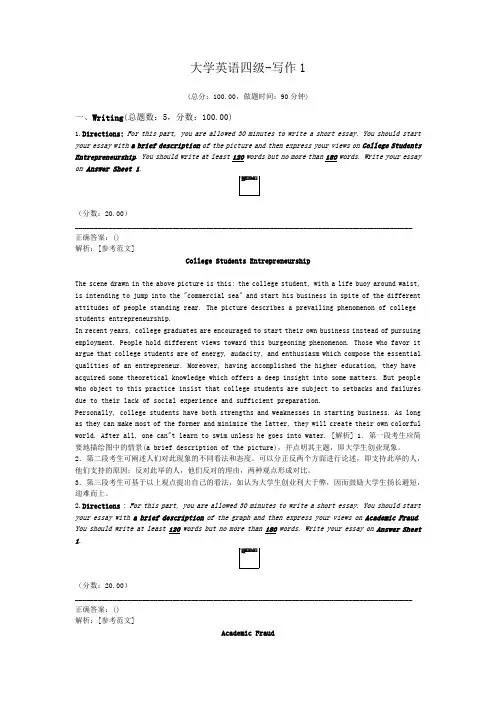
大学英语四级-写作1(总分:100.00,做题时间:90分钟)一、Writing(总题数:5,分数:100.00)1.Directions:For this part, you are allowed 30 minutes to write a short essay. You should start your essay with a brief description of the picture and then express your views on College Students Entrepreneurship. You should write at least 120words but no more than 180words. Write your essay on Answer Sheet 1.(分数:20.00)__________________________________________________________________________________________ 正确答案:()解析:[参考范文]College Students EntrepreneurshipThe scene drawn in the above picture is this: the college student, with a life buoy around waist, is intending to jump into the "commercial sea" and start his business in spite of the different attitudes of people standing rear. The picture describes a prevailing phenomenon of college students entrepreneurship.In recent years, college graduates are encouraged to start their own business instead of pursuing employment. People hold different views toward this burgeoning phenomenon. Those who favor it argue that college students are of energy, audacity, and enthusiasm which compose the essential qualities of an entrepreneur. Moreover, having accomplished the higher education, they have acquired some theoretical knowledge which offers a deep insight into some matters. But people who object to this practice insist that college students are subject to setbacks and failures due to their lack of social experience and sufficient preparation.Personally, college students have both strengths and weaknesses in starting business. As long as they can make most of the former and minimize the latter, they will create their own colorful world. After all, one can"t learn to swim unless he goes into water. [解析] 1.第一段考生应简要地描绘图中的情景(a brief description of the picture),并点明其主题,即大学生创业现象。
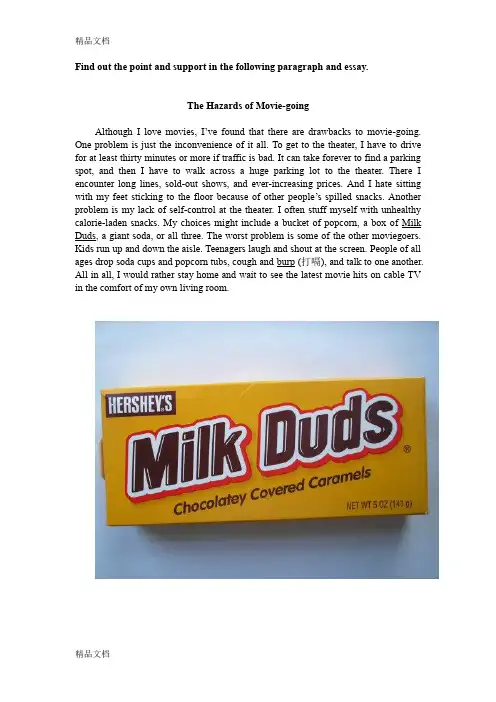
Find out the point and support in the following paragraph and essay.The Hazards of Movie-goingAlthough I love movies, I’ve found that there are drawbacks to movie-going. One problem is just the inconvenience of it all. To get to the theater, I have to drive for at least thirty minutes or more if traffic is bad. It can take forever to find a parking spot, and then I have to walk across a huge parking lot to the theater. There I encounter long lines, sold-out shows, and ever-increasing prices. And I hate sitting with my feet sticking to the floor because of other people’s spilled snacks. Another problem is my lack of self-control at the theater. I often stuff myself with unhealthy calorie-laden snacks. My choices might include a bucket of popcorn, a box of Milk Duds, a giant soda, or all three. The worst problem is some of the other moviegoers. Kids run up and down the aisle. Teenagers laugh and shout at the screen. People of all ages drop soda cups and popcorn tubs, cough and burp (打嗝), and talk to one another. All in all, I would rather stay home and wait to see the latest movie hits on cable TV in the comfort of my own living room.The Hazards of Movie-goingI am a movie fanatic. My friends count on me to know movie trivia and to remember every big Oscar awarded since I was in grade school. My friends, though, have stopped asking me if I want to go out to the movies. While I love movies as much as ever, the inconvenience of going out, the temptations of the theater, and the behavior of some patrons are reasons for me to wait and rent the video.To begin with, I just don’t enjoy the general hassle (trouble) of the evening. Since small local movie theaters are a thing of the past, I have to drive for thirty minutes to get to the nearest multiplex. The parking lot is shared with several restaurants and a supermarket, so it’s always jammed. I have to drive around at a snail’s pace (像蜗牛般爬行) until I spot another driver backing out. Then it’s time to stand in an endless line, with the constant threat that tickets for the show I want will sell out. If we do get tickets, the theater will be so crowded that I won’t be able to sit with my friends, or we’ll have to sit in a front row gaping up at a giant screen. I have to shell out (pay) a ridiculous amount of money ―up to $8 ―for a ticket. That entitles me to sit while my shoes seal themselves to a sticky floor coated with spilled soda, bubble gum, and crushed Raisinets.Second, the theater offers tempting snacks that I really don’t need. Like most of us, I have to battle an expanding waistline. At home I do pretty well by simply not buying stuff that is bad for me. I can make do with (设法/勉强应付) snacks like celery (芹菜) and carrot sticks because there is no ice cream in the freezer. Going to the theater, however, is like spending my evening in a Seven-Eleven that’s been equipped with a movie screen and comfortable seats. As I try to persuade myself to just have a diet Coke, the smell of fresh popcorn dripping with butter soon overcomes me. Chocolate bars, the size of small automobiles, seem to jump into my hands. I risk pulling out my fillings (补牙用填料) as I chew enormous mouthfuls of Milk Duds. By the time I leave the theater, I feel disgusted with myself.Many of the other patrons are even more of a problem than the concession stand (影院里的贩卖处). Little kids race up and down the aisles, usually in giggling packs. Teenagers try to impress their friends by talking back to (反驳/回嘴) the screen, whistling, and making what they consider to be hilarious (欢闹的) noises. Adults act as if they were at home in their own living room. They comment loudly on the ages of the stars and reveal plot twists that are supposed to be a secret until the film’s end. And people of all ages create distractions. They crinkle (弄皱) candy wrappers, stick gum on their seats, and drop popcorn tubs or cups of crushed ice and soda on the floor. They also cough and burp, squirm (蠕动) endlessly in their seats, file out (鱼贯而出) for repeated trips to the rest rooms or concession stands, and elbow me out of the armrest on either side of my seat.After arriving home from the movies one night, I decided that I was not going to be a moviegoer anymore. I was tired of the problems involved in getting to the theater, resisting unhealthy snacks, and dealing with the patrons. The next day, I arranged to have premium (额外花费) movie channels installed as part of my cable TV service, and I also got a membership at my local video store. I may now see movies a bit later than other people, but I’ll be more relaxed watching box office hits in the comfort of my own living room.。
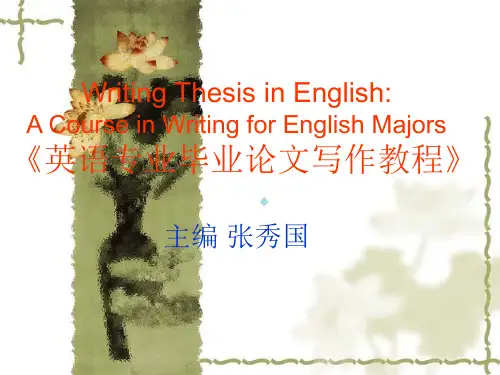
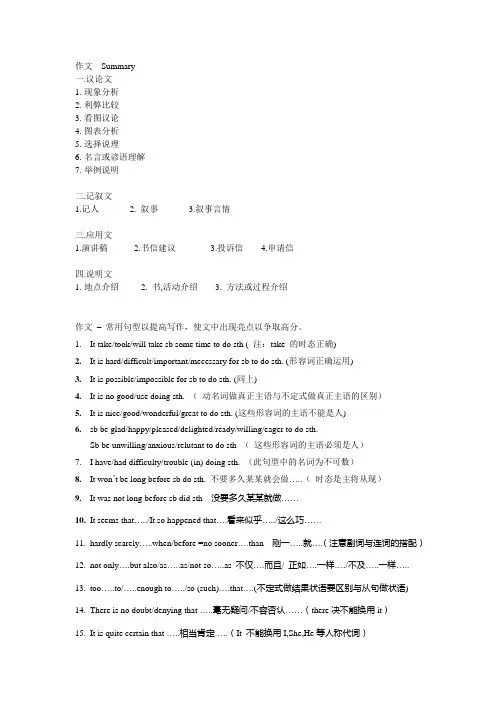
作文Summary一.议论文1.现象分析2.利弊比较3.看图议论4.图表分析5.选择说理6.名言或谚语理解7.举例说明二.记叙文1.记人2. 叙事3.叙事言情三.应用文1.演讲稿2.书信建议3.投诉信4.申请信四.说明文1.地点介绍2. 书,活动介绍3. 方法或过程介绍作文–常用句型以提高写作,使文中出现亮点以争取高分。
1.It take/took/will take sb some time to do sth ( 注:take 的时态正确)2.It is hard/difficult/important/mecessary for sb to do sth. (形容词正确运用)3.It is possible/impossible for sb to do sth. (同上)4.It is no good/use doing sth. (动名词做真正主语与不定式做真正主语的区别)5.It is nice/good/wonderful/great to do sth. (这些形容词的主语不能是人)6.sb be glad/happy/pleased/delighted/ready/willing/eager to do sth.Sb be unwilling/anxious/relutant to do sth (这些形容词的主语必须是人)7.I have/had difficulty/trouble (in) doing sth. (此句型中的名词为不可数)8.It won’t be long before sb do sth. 不要多久某某就会做…..(时态是主将从现)9.It was not long before sb did sth 没要多久某某就做……10.It seems that…../It so happened that….看来似乎…../这么巧……11.hardly scarely…..when/before =no sooner….than 刚一…..就….(注意副词与连词的搭配)12.not only….but also/as…..as/not so…..as 不仅….而且/ 正如….一样…./不及…..一样…..13.too…..to/…..enough to…../so (such)….that….(不定式做结果状语要区别与从句做状语)14.There is no doubt/denying that …..毫无疑问/不容否认……(there决不能换用it)15.It is quite certain that …..相当肯定…..(It 不能换用I,She,He等人称代词)16.It is no wonder that …../ No wonder that….难怪17.Great changes have taken place in our hometown/Our hometown has greatly changed.18.I always take/took it for granted that ….我总是想当然地认为19.spend/waste some time/money (in) doing sth/on sth 花费时间或金钱做某事20.sb make great contributions to +n/doing 为….做出很大贡献21.devote oneself/one’s time /one’s energy/one’s money to 把自己的一生/精力/金钱致力与….22.make preparations for …./ prepare for ….为…做准备23.sth be worth doing/be worthy of being done/ be worthy to be done …..值得做24.sth be worth + n. ( one’s effort/ a visit/ one’s discussion) …..,值得(努力/参观/讨论)25.place/put/lay emphasis on ….把重点放在…/speak with emphasis 强调地说26.pay much/great attention to ….特别注意…./重视….27.It occurs to /comes to / strikes me that ….我想到….Practice:现在高中生申请出国的现象非常普遍,人们对此的看法不一,请你谈谈对此事的看法.现象分析Para I : 点出热点话题或简要描述某种现象。


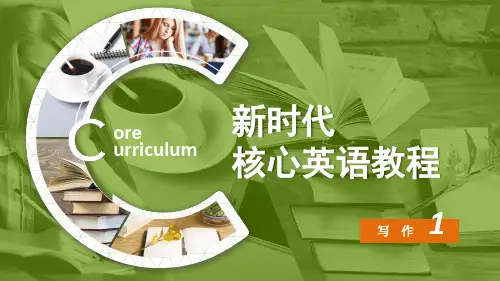
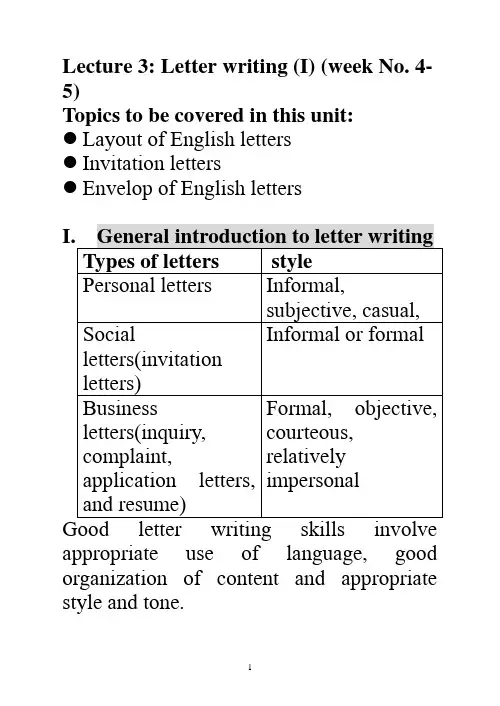
Lecture 3: Letter writing (I) (week No. 4-5)Topics to be covered in this unit:●Layout of English letters●Invitation letters●Envelop of English lettersappropriate use of language, good organization of content and appropriate style and tone.II. Layout of English lettersA formal English letter is generally composed of six parts:信头 ( Letterhead) 收信人姓名地址 (Inside address) 称呼 (Salutation)正文(Body) 结束敬语(Complimentary close) 署名 (Signature)Task: Below is a formal invitation letter in full-blocked format. Ask the students to study it carefully, identify each part and talk about the differences between Chinese letters and English letters. Sample 1: 邀请某位教授参加计算机年会的信函1.Dept. of Computer ScienceFudan UniversityShanghai 200433PR ChinaMarch 15th, 20012.Prof. Woodrow BushyDept. of ComputerNew York UniversityNew YorkUSA3.Dear Prof. Bushy:4.Re: Invitation to Annual Computer Society Conference in September 2001 5.It is with great pleasure that I invite you to the 11th Annual Computer SocietyConference. This year's conferencewill be held in Beijing from September23 through September 27.We are offering a valuable program with industry-wide applications by speakers who are recognized experts in their fields on topics with many implications for the future. Ample time is scheduled for discussion periods. In addition, tours to two large computer companies will be arranged.Enclosed please find information on accommodations, transportation and registration.If you have any questions, please call the session coordinator, Julie Han at 86-21-82316661.6.Yours sincerely,7.(signature)Wang QiangChairmanDept. of Computer Science8.WN/kpl9.Encl.:Information on accommodations, transportation and registration.Introduce the important features and conventions of each part and ask the students to read through the handout after class. We may ask the students to practice writing at the same time. Forexample, ask them to write a letterhead after we talk about it.1.Letterhead(信头)This part includes the address of the writer and the date of writing. It helps the recipient identify where the letter was from and when written so as to answer with convenience. Call students’ attention to the different address and date writing between English and Chinese:The address is arranged in English in the order of the house number and name of the street(road or avenue); the name of the city (town); and the name of the state(province or county) and may also include the post code,; and then the name of the country. (The name of the country in the address is usually omitted if the writer and the reviver of the letter are in the same country.)e.g.100083中国北京市海淀区学院路37号37 Xueyuan Road,Haidian District,Beijing 100083,PR China.地址缩写词:A VE = Avenue E = East W = West RD = RoadBLDG = Building EXPY = Expressway DST = District FLT =FlatHWY = Highway SQ = Square INST = InstituteIn English the date is written in this way:April 30, 2001,(AE)or 30 April, 2001(BE)Year: be given in full in full form.Month: be written in complete form or acceptably abbreviated forms, to avoid misunderstanding (e.g.5/12/ 2003)January (Jan.), February (Feb.), March(Mar.), April (Apr.), May, June, July,August (Aug.), September (Sept.),October (Oct.), November (Nov.),December (Dec.)Day: both cardinal and ordinal numbers are okComma may or may not be used.Call the students’ attention to the differences in American English and British English letterhead writing: The Americans prefer the order of month, day and year; while the British prefer the order of day, month and year.The Americans prefer no punctuation at the end of each line; while the British prefer a comma after each line and a period after the last line.In AE. 122 Third AVE.New York, N.Y. 10017U.S.A.Jan.18,1999In BE. 122 Third AVE.,New York, N.Y. 10017,U.S.A..18 Jan.,19992.Inside Address (收信人姓名地址) This part refers to the address of the recipient, which includes the recipient’s name, title and address.The way to write the address should be exactly the same as that on the envelope. Guidelines:Know the name of the receiver: use full name and title.E.g. Mr., Mrs. , Miss, Ms. … ; or Dr.David SmithDavid Smith, Jr. (Sr. , or Ph.D.)Don't know who will read your letter , address your letter directly to the organization concerned.E.g. Harper and Grant Ltd.Write to a particular person in a company or organization, but don’t know his or her name.E.g. The Manager, The Director, The Chairman, The Sales Manager, The Secretary.If the name and title are long, indent the second line two spaces.E.g. Executive Secretary toThe Chairman3.Salutation (称呼): a greeting to the addresseeUsually two spaces below the inside address against the left margin.The British tend to use a comma after the salutation and the Americans a colon (esp. In business letter).Each word in the salutation must start with a capital letter.How to salute depends on how you are related to the addressee.在正式英语信件中,则要根据收信人是谁而进行相应的变动。
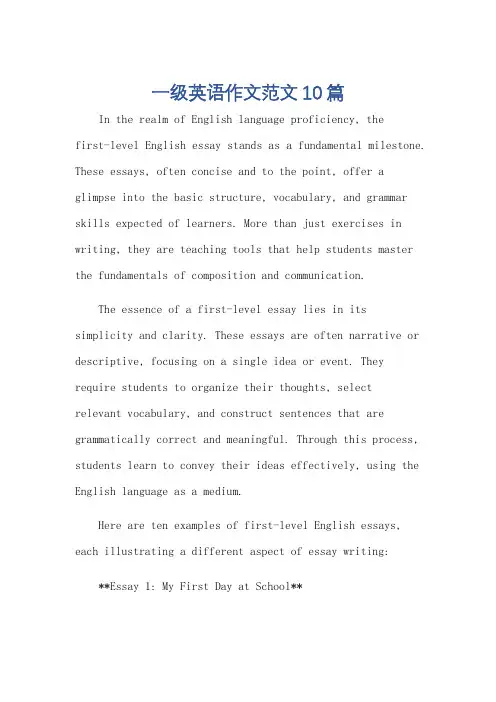
一级英语作文范文10篇In the realm of English language proficiency, thefirst-level English essay stands as a fundamental milestone. These essays, often concise and to the point, offer a glimpse into the basic structure, vocabulary, and grammar skills expected of learners. More than just exercises in writing, they are teaching tools that help students master the fundamentals of composition and communication.The essence of a first-level essay lies in itssimplicity and clarity. These essays are often narrative or descriptive, focusing on a single idea or event. Theyrequire students to organize their thoughts, selectrelevant vocabulary, and construct sentences that are grammatically correct and meaningful. Through this process, students learn to convey their ideas effectively, using the English language as a medium.Here are ten examples of first-level English essays, each illustrating a different aspect of essay writing:**Essay 1: My First Day at School**On my first day at school, I felt nervous and excited. The school building was huge, and there were so many new faces. My teacher was kind, and she helped me feel welcome.I learned many new things that day, and I made some new friends. It was a special day for me.**中文翻译:****我的第一天上学**我第一天上学时,既紧张又兴奋。
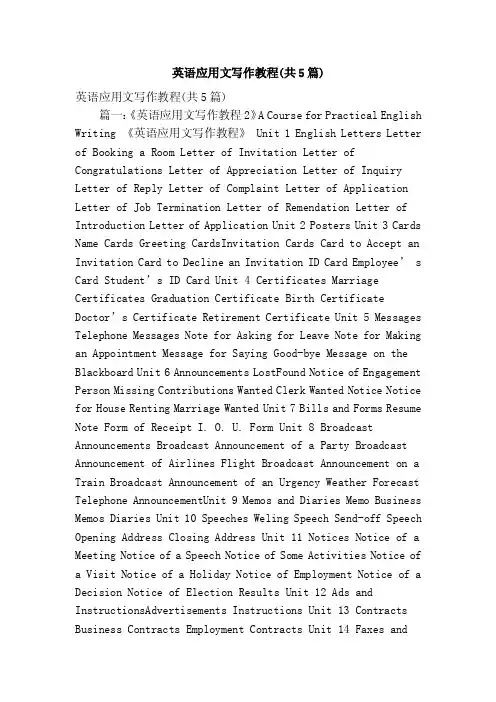
英语应用文写作教程(共5篇)英语应用文写作教程(共5篇)篇一:《英语应用文写作教程2》A Course for Practical English Writing 《英语应用文写作教程》 Unit 1 English Letters Letter of Booking a Room Letter of Invitation Letter of Congratulations Letter of Appreciation Letter of Inquiry Letter of Reply Letter of Complaint Letter of Application Letter of Job Termination Letter of Remendation Letter of Introduction Letter of Application Unit 2 Posters Unit 3 Cards Name Cards Greeting CardsInvitation Cards Card to Accept an Invitation Card to Decline an Invitation ID Card Employee’ s Card S tudent’s ID Card Unit 4 Certificates Marriage Certificates Graduation Certificate Birth Certificate Doctor’s Certificate Retirement Certificate Unit 5 Messages Telephone Messages Note for Asking for Leave Note for Making an Appointment Message for Saying Good-bye Message on the Blackboard Unit 6 Announcements LostFound Notice of Engagement Person Missing Contributions Wanted Clerk Wanted Notice Notice for House Renting Marriage Wanted Unit 7 Bills and Forms Resume Note Form of Receipt I. O. U. Form Unit 8 Broadcast Announcements Broadcast Announcement of a Party Broadcast Announcement of Airlines Flight Broadcast Announcement on a Train Broadcast Announcement of an Urgency Weather Forecast Telephone AnnouncementUnit 9 Memos and Diaries Memo Business Memos Diaries Unit 10 Speeches Weling Speech Send-off Speech Opening Address Closing Address Unit 11 Notices Notice of a Meeting Notice of a Speech Notice of Some Activities Notice of a Visit Notice of a Holiday Notice of Employment Notice of a Decision Notice of Election Results Unit 12 Ads and InstructionsAdvertisements Instructions Unit 13 Contracts Business Contracts Employment Contracts Unit 14 Faxes andEmails E-mail Reply to an E-mail Fax Resume 图片已关闭显示,点此查看图片已关闭显示,点此查看图片已关闭显示,点此查看图片已关闭显示,点此查看图片已关闭显示,点此查看图片已关闭显示,点此查看篇二:英语应用文写作课程简介英语应用文写作(Practical English Writing)课程简介课程编号: 050249 学时:32 课程类型:任选课先修课程:英语应用文写作适用专业:非英语专业本科实验班、卓越班等本课程的培养目标为:通过实施过程式教学法使学生掌握应用文的写作方法,真正提高他们运用英语的能力。
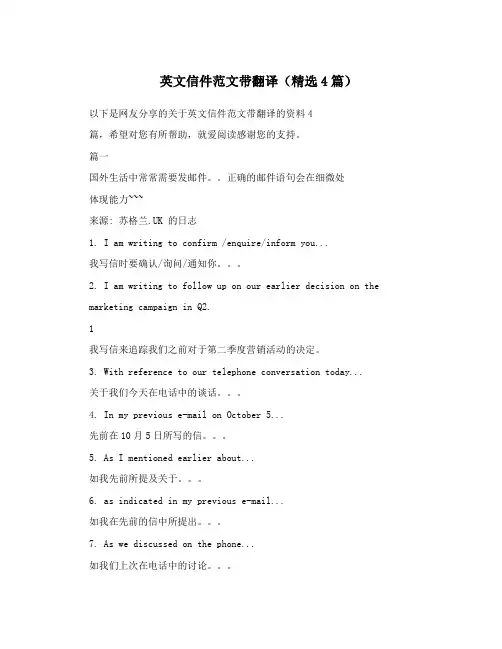
英文信件范文带翻译(精选4篇)以下是网友分享的关于英文信件范文带翻译的资料4篇,希望对您有所帮助,就爱阅读感谢您的支持。
篇一国外生活中常常需要发邮件。
正确的邮件语句会在细微处体现能力~~~来源: 苏格兰.UK 的日志1. I am writing to confirm /enquire/inform you...我写信时要确认/询问/通知你。
2. I am writing to follow up on our earlier decision on the marketing campaign in Q2.1我写信来追踪我们之前对于第二季度营销活动的决定。
3. With reference to our telephone conversation today...关于我们今天在电话中的谈话。
4. In my previous e-mail on October5...先前在10月5日所写的信。
5. As I mentioned earlier about...如我先前所提及关于。
6. as indicated in my previous e-mail...如我在先前的信中所提出。
7. As we discussed on the phone...如我们上次在电话中的讨论。
8. from our decision at the previous meeting...2如我们在上次会议中的决定。
9. as you requested/per your requirement...按照你的要求。
10.In reply to your e-mail dated April 1,we decided...回答你在4月1日写的信,我们决定。
11.This is in response to your e-mail today.这是针对你今天早上来信的回复。
12. As mentioned before, we deem this product has strong unique selling points in china.如先前所述,我们认为这个产品在中国有强有力且独一无二的销售点。
英语一作文书写Certainly, I understand you need to write an English essay without revealing your prompt. Below is a sampleessay that meets your requirements:Title: The Impact of Technology on Modern Society。
In today's fast-paced world, technology plays an increasingly integral role in shaping our society. From communication to education, transportation to entertainment, technology has revolutionized every aspect of our lives. In this essay, I will explore the multifaceted impact of technology on modern society.First and foremost, technology has transformed the way we communicate. The advent of smartphones and social media platforms has made it easier than ever to connect with people across the globe instantly. Whether through text messages, emails, or video calls, individuals can now communicate in real-time, transcending geographicalbarriers. This interconnectedness has facilitated the exchange of ideas, cultures, and information on an unprecedented scale, fostering greater understanding and collaboration among people worldwide.Furthermore, technology has revolutionized the field of education. The internet has become a vast repository of knowledge, offering endless opportunities for learning and skill development. Online courses, tutorials, and educational websites have democratized access to education, allowing individuals to pursue their academic interests regardless of their geographical location or socioeconomic background. Additionally, digital tools such as interactive whiteboards and educational apps have enhanced the learning experience, making it more engaging and immersive for students of all ages.In addition to communication and education, technology has also had a profound impact on transportation. The invention of automobiles, airplanes, and high-speed trains has transformed the way we travel, making it faster, safer, and more convenient than ever before. Moreover, theemergence of ride-sharing services and autonomous vehicles promises to revolutionize urban mobility, reducing traffic congestion and carbon emissions in the process. As technology continues to advance, the transportation landscape will likely undergo further transformation, ushering in a new era of sustainable and efficient mobility.Furthermore, technology has revolutionized the entertainment industry, offering a plethora of digital content ranging from streaming services to virtual reality experiences. Platforms like Netflix, Spotify, and YouTube have democratized access to entertainment, allowing consumers to enjoy their favorite movies, music, and shows anytime, anywhere. Additionally, advancements in CGI and special effects have raised the bar for visual storytelling, immersing audiences in rich and immersive worlds like never before. As technology continues to evolve, the boundaries between reality and fiction will continue to blur, opening up new possibilities for creative expression and entertainment.In conclusion, technology has fundamentally transformedmodern society in profound and far-reaching ways. From communication to education, transportation to entertainment, technology has revolutionized every aspect of our lives, reshaping the way we work, live, and interact with one another. While the impact of technology is undeniably positive in many respects, it also presents challenges and complexities that must be addressed. As we navigate theever-changing landscape of technology, it is essential to harness its potential for the greater good while mitigating its negative consequences. Only by doing so can we ensure a future where technology serves as a force for progress and prosperity for all.。
公共英语一级书信作文范文English:Dear Sir/Madam,I am writing this letter to express my concerns about the traffic congestion in our city. The increasing number of vehicles on the roads has resulted in long delays, especially during rush hours. This not only affects the daily commute of citizens but also contributes to air pollution. I believe that this issue can be addressed by improving public transportation and encouraging the use of alternative modes of transport such as cycling and walking. By investing in better infrastructure and promoting eco-friendly ways of commuting, we can reduce traffic congestion and create a more sustainable environment for everyone. I urge the local authorities to take immediate action to tackle this problem before it escalates further. Thank you for your attention to this matter.Yours sincerely,[Your Name]中文翻译:尊敬的先生/女士,我写这封信是为了表达我对我们城市交通拥堵问题的担忧。
题型五应用文写作题组1Writing 1 [ 介绍信][2020 山东统考]假定你是李华,你的英国朋友John 来信询问中国人过春节的风俗习惯。
请你结合自己家乡的实际情况给他回信,内容包括:1. 春节的简介;2. 过春节的风俗习惯;3. 邀请他来中国过春节。
注意:1. 词数80 左右;2. 可以适当增加细节, 以使行文连贯。
Writing 2 [ 感谢信][2020 浙江金丽衢十二校联考]假定你是李华,暑期在英国旅游时得到当地导游Mr. Smith 的悉心照顾,回国后打算给他写一封邮件表达谢意。
主要内容:1. 回忆旅行中美好时光;2. 遇到的困难和得到的帮助;3. 邀请他来中国旅游。
注意:1. 词数80 左右;2. 可适当增加细节,以使行文连贯。
Writing 3 [ 道歉信]假定你叫李华,你与班上来自英国的交换生Mike 约定周日去购买他喜欢的中国历史书籍,但你临时有事不能赴约。
请你给他写一封邮件说明情况,内容包括:1. 表示你的歉意;2. 解释失约原因3. 重新约定时间注意:1. 词数80 左右;2. 可以适当增加细节, 以使行文连贯Writing 4 [ 通知] 假定你是某国际学校的学生会主席李华,请你写一则通知,为学校近期要举行的排球比赛(the 2020Student Volleyball Match) 招募志愿者。
内容包括:1. 招募目的;2. 招募条件;3. 培训时间和地点。
注意:1. 词数80 左右;2. 可以适当增加细节, 以使行文连贯。
Writing 5 [ 投诉信]假定你是李华,一周前在一英国网站购得一个智能手环,但因为质量问题不能使用, 请你给客服人员写一封电子邮件。
内容如下:1. 反映存在的问题(如不能测量运动步数和心率,日历不准确等);2. 提出解决方案。
注意:1. 词数80 左右;2. 可以适当增加细节, 以使行文连贯。
参考词汇:智能手环smartbandWriting 6 [ 新素材]假如你是李华,你的英国朋友Joe 看到有关新型冠状病毒肺炎的报道,得知中国很多学校因新冠肺炎疫情而推迟开学,发邮件向你询问你学校的情况。
Find out the point and support in the follow ing paragraph and essay.The Hazards of Movie-go ingAlthough I love movies, I ' vfound that there are drawbacks to movie-going. One problem is just the inconvenience of it all. To get to the theater, I have to drive for at least thirty minutes or more if traffic is bad. It can take forever to find a parking spot, and then I have to walk across a huge parking lot to the theater. There I encounter long lines, sold-out shows, and ever-increasing prices. And I hate sitting with my feet stick ing to the floor because of other people s spilled sn acks. Ano ther problem is my lack of self-control at the theater. I often stuff myself with unhealthy calorie-lade n sn acks. My choices might in clude a bucket of popcor n, a box of Milk Duds, a giant soda, or all three. The worst problem is some of the other moviegoers. Kids run up and dow n the aisle. Teen agers laugh and shout at the scree n. People of all ages drop soda cups and popcor n tubs, cough and bur打嗝),and talk to one ano ther. All in all, I would rather stay home and wait to see the latest movie hits on cable TV in the comfort of my own living room.The Hazards of Movie-go ingI am a movie fanatic. My friends count on me to know movie trivia and to remember every big Oscar awarded since I was in grade school. My frie nds, though, have stopped asking me if I want to go out to the movies. While I love movies as muchas ever, the inconvenience of going out, the temptations of the theater, and the behavior of some patr ons are reas ons for me to wait and rent the video.To beg in with, I just don't enjoy the gen eral hassle (trouble) of the eve ning. Since small local movie theaters are a thing of the past, I have to drive for thirty minutes to get to the nearest multiplex. The parking lot is shared with several restaurantsand a supermarket, so it ' always jammed. I have to drive around at a snail'space 像蜗牛般爬行)until I spot another driver backing out. Then it 'time to stand in an endless line, with the constant threat that tickets for the show I want will sell out. If we do get tickets, the theater will be so crowded that I won 'be able to sit with my friends, or we 'll have to sit in a front row gaping up at a giant screen. I have to shell out (pay) a ridiculous amount of money —up to $8 —for a ticket. That en titles me to sit while my shoes seal themselves to a sticky floor coated with spilled soda, bubble gum, and crushed Raisinets.Second, the theater offers tempting snacks that I really do' need. Like most of us, I have to battle an expa nding waistl ine. At home I do pretty well by simply not buying stuff that is bad for me. I can make do with (设法/勉强应付)snacks like celery (芹菜)and carrot sticks because there is no ice cream in the freezer. Going to the theater, however, is like spending my evening in a Seven-Eleven that's been equipped with a movie screen and comfortable seats. As I try to persuade myself to just have a diet Coke, the smell of fresh popcorn dripping with butter soon overcomes me. Chocolate bars, the size of small automobiles, seem to jump into my han ds. I risk pulling out my fillings (补牙用填料)as I chew enormous mouthfuls of Milk Duds. By the time I leave the theater, I feel disgusted with myself.Many of the other patr ons are eve n more of a problem tha n the con cessi on sta nd (影院里的贩卖处).Little kids race up and down the aisles, usually in giggling packs. Teenagerstry to impress their friends by talking back to (反驳/回嘴)the screen, whistling, and making what they consider to be hilarious (欢闹的)noises. Adults act as if they were at home in their own liv ing room. They comme nt loudly on the ages of the stars and reveal plot twists that are supposed to be a secret until the film 'send. And people of all ages create distract ions. They crin kle (弄皱)candy wrappers, stick gum on their seats, and drop popcor n tubs or cups of crushed ice and soda on the floor. They also cough and burp, squirm (蠕动)endlessly in their seats,(鱼贯而出)for repeated trips to the rest rooms or con cessi on sta nds, and elbow me out of the armrest on either side of my seat.After arriving home from the movies one night, I decided that I was not going to be a moviegoer anymore. I was tired of the problems involved in getting to the theater, resisti ng un healthy sn acks, and deali ng with the patr ons. The n ext day, I arran ged to have premium (额外花费)movie cha nn els in stalled as part of my cable TV service, and I also got a membership at my local video store. I may now see movies a bit latertha n other people, but 'be more relaxed watch ing box office hits in the comfort of my own livi ng room.ME'1门。
《美国大学英语写作》课后习题答案(PART 1) ANSWER KEYPart One: Essay Writing1 An Introduction to WritingActivity (Point and Support in a Paragraph), pages 5–6 Point: There are drawbacks to moviegoing.Support: 1. Inconvenienceb. Long time to find parking spot and long walk to theaterd. Sticky floor3. Other moviegoersa. Running kidsb. Laughing, shouting teenagersActivity (Introductory Paragraph), 81. c2. b3. a4. a. Inconvenience of going outb. Temptations of the theaterc. Behavior of some patronsActivity (Body: Supporting Paragraphs), 9–101. To begin with, I just don’t enjoy the general hassleof the evening.2. b. Parking lot is always jammedd. Tickets may sell out, and theater is crowdede. Tickets cost up to $8 each3. Second, the theater offers tempting snacks that I really don’t need.4. b. 2) chocolate bars3) Milk Duds5. Many of the other patrons are even more of a problem than the concession stand.6. a. Little kids race up and down the aislesb. Teenagers talk back to the screen, whistle, make funny noisesActivity (Concluding Paragraph), 101. a2. cReview Activities, 18–20Answers will vary.2 The Writing ProcessActivities (Freewriting, Questioning, Making a List, Clustering, Scratch Outline), 25–31Answers will vary.Activity (Writing a First Draft), 331. thesis 5. specific2. first 6. bs3. equiped (other answers are possible) 7.conclusion4. second and thirdActivity (Revising with a Second Draft), 36–371. Second 5. watching what I keep in the house2. however 6. comfortable seats3. unity . . . My friends are as bad as I am.7. As4. support . . . snacks like celery and carrot8. jump into my handssticks . . . no ice cream in the freezer . . .9. disgusteddripping with butter . . . risk pulling out。
D. The Paragraph
1.Effective paragraphs.
(1)Unity:
Unity of a paragraph is concerned with its content.If all the sentences in the paragraph lead to one central theme,the paragraph is unified.The central theme is usually summarized in what is called the topic sentence.
2.Ways of developing paragraphs.
1>Development by time.
In telling a story or recounting an event, the easiest and clearest way is to
describe things in order of time. The
method is also called chronological
sequencing.
2>Development by process.
When you have to explain how something is
done, you usually follow a chronological
sequence and give a step-by-step description.
As the steps must occur one after another, the exact order in which they are carried out is
most important. In giving instructions,
imperative sentences and sentences with the
indefinite pronoun you as the subject are often used. The present tense should be used if the
instructions are still applicable.
3>Development by space.
Before we begin to describe a place,
whether it is a large country or a small
room, we have to decide on the order in
which to name the different parts or
details. For this we should find out the
space relationships between them and
arrange our description accordingly. It
would only confuse the reader to mention them in a haphazard way.
4>Development by example or generalization.
Supporting a topic sentence with examples or illustrations makes a general statement specific and easy to understand.An illustration is a case,a specimen,an instance.Vivid illustrations light up abstract ideas and make them clear, interesting,memorable,or convincing.。